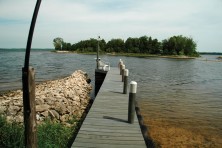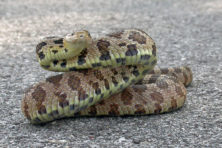Snake Snippets
- Share
- Tweet
- Pin
- Share
• Soldiers in Vietnam called the Many Banded Krait, a poisonous snake living in the jungles of Southeast Asia, the “Two Step Snake.” If it bit you, you’d take two steps and die. While not technically true, its bite does carry enough toxin to kill two dozen adult men.
• The largest venomous snake in the New World is the Bushmaster, which can reach 12 feet in length. Fortunately it is very rare.
• The Black Rat Snake, native of the eastern United States, can climb trees that are 40 feet high.
• The Boa Constrictor, whose habitat is rain forests in Central and South America, feeds at night. It has thermal sensitive facial scales that enable it to locate prey in the dark. It kills by coiling its body around the victim and squeezing. Once the prey is unconscious or dead, the snake swallows it whole. It can consume a white-tailed deer.
• The most common venomous snake in North America is the American Copperhead. Its venom is comparatively weak, however, and a bite seldom results in a human death.
• An old folk tradition says that cobras can be mesmerized by music. This is untrue because cobras are deaf. The snake charmer’s flute is just for show. He directs the snake’s movements by swaying his head.
• The King Cobra deserves its reputation as a truly frightening snake. When threatened, it expands its hood and raises the upper third of its body five to six feet off the ground – making it tall enough to stare into a grown man’s eyes.
• The Burmese Spitting Cobra disables predators by directing a stream of venom at their eyes. This snake existed as a myth until 2000, when it was identified by scientists.
• The tiny Pygmy rattlesnake is so small that when coiled on the ground, it is the size of a pine cone.
• The Gaboon Viper of equatorial Africa has fangs up to two inches long.
• The fable of snakes that fly is not a fable. Golden Tree Snakes can jump from tree to tree and soar for distances of up to a hundred yards. When in the air, they undulate as if swimming.
• In Burma there are professional snake catchers, hired by villagers to remove the venomous snakes that are a constant threat to human life. The snake catchers have bodies covered with tattoos whose ink is infused with snake venom. They believe the tattoos make them safe from toxic snake bites.
• The outback of Australia is home to the Inland Taipan, a snake with the most toxic venom of any species of snake in the world. “One bite could kill a hundred grown men.” But no bites have been recorded due to its extremely remote habitat.
Source: Information from The Snake Charmer, A Life and Death in the Pursuit of Knowledge by Jamie James, 2009.



